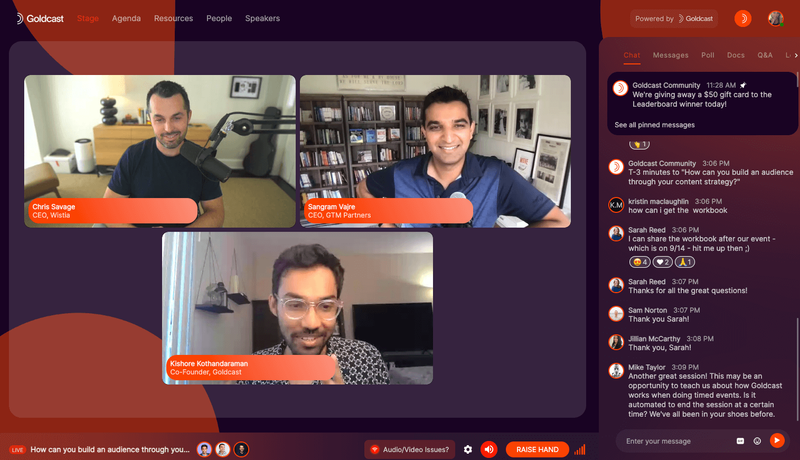How Terminus and Wistia Drive Growth with a Media-Centric Content Strategy

Maximize Your Marketing ROI
Join 10,000 other marketers already getting the best tips on running engaging events that boost pipeline and create raving fans.
“Market like a media company” has been a buzzy phrase in the B2B community for a few years now, but what does that actually mean? And what do brands have to gain by taking a media-centric approach to content and marketing?
Kishore Kothandaraman, Goldcast Co-Founder and CMO, led a lively session with Sangram Vajre or Terminus and Chris Savage of Wistia, where they revealed whether the “media company” strategy is worth the hype.
Check out the full season on-demand and our top takeaways below ⤵️
Takeaway 1: As the quantity of content available has increased, the quality has decreased
To begin, the cost of creating content has massively decreased. This is a good thing—it means content has become more accessible, and the barrier to entry is lower. However, it also has a downside. Since the floodgates have opened, some would argue the quality of content has come down too. Most of the content out there is super fluffy and devoid of actual value.
Interestingly, as the quality is on the downswing, authentic content is on the rise. Posts on LinkedIn, Substack, etc., are becoming more popular because people want to hear real stuff.
The bar is so low on creating good, authentic content but people are afraid to take the leap on great quality and are boxed into numbers.”
Looking at it from the audience's perspective, everyone is used to having a plethora of options. If you want to watch, listen, read, or scan, you can. In this world of unlimited content, you must be willing to go deep with different mediums to give them options on how they want to engage with content.
People will spend the time if they care about the content and it’s convenient for them. For example, someone will watch a one-minute LinkedIn video or scan something you have written if they have a connection to it. If they really care about your topic, they will also go and listen to an hour-long podcast.
The takeaway is that people learn and discover content differently. Some people are visual learners, some need to read, and some need to do. The trick is to give them unlimited choice and the option to go deep if they want to.
Takeaway 2: Building a media company is a long-term strategy—there are no shortcuts
Many companies idolize SaaStr, as an example, but it’s important to consider the full context. SaaStr is a true media company. They’re selling access to content and building a personal brand. So while they’re a great example, it’s important to recognize they’ve been doing this for a long time.
The truth is, you have to do something consistently for a long time for it to start paying off. In this world, if you do something every day, guess what, in one year, five years, etc., it will be better.
People go into it looking for short-term results, and they get short-term results but measure it against long-term metrics. And this is the wrong way to think about it.”
Instead, pay attention to qualitative first. Get through the beginning when you get good feedback but don’t have enough momentum to get quantitative results. If you put in the work, stick with it, and focus on quality over quantity—the numbers will follow.
Takeaway 3: Gated content is ok, but marketers should use it strategically
Some people love to gate content sometimes because it drives email growth. While this can be an effective strategy, it's not the best experience for your audience (and doesn’t usually drive quality leads).
Truthfully, every website only needs one piece of gated content—that’s it. That is the ultimate piece of content you want to have everywhere (think of it as a cornerstone campaign asset). Everything else should point to it, and everything else can be free.
For example, at Terminus, they’re creating a comprehensive go-to-market guide. This is the only piece of content they are looking to gate. Everything else—podcast, blog, social post—will always point back to this.

Wistia has tried a few different things. Most recently, they released a new project called Show Business, an impressive 20-video educational series.
It started off gated, and you had to sign up with an email to get access. They got thousands of emails, and the sales team vetted these leads. Some worked, some didn’t, and after a point, they were done with the process.
Wistia knew the content was valuable and knew they could do more things with it. So, they made it ungated, distributed smaller clips across different channels, and created a whole library of supporting content. Eventually, it was on YouTube, as well.
This can be thought of as similar to what happens with a movie premiere. After it hits the theaters, where people pay a premium to see it first, it becomes available for rent. Then it’s on airplanes, and a little later it’s available on-demand for home viewing.
It's useful to view all your content through this lens so you can make decisions on gated content more efficiently.

Stay In Touch
Platform
Resources
Company
Community
© 2025 Copyright Goldcast, Inc. All rights reserved.



 Upcoming Events
Upcoming Events Event Series
Event Series On-Demand Events
On-Demand Events

